多恩布什宏观经济学[01,导论]
- 格式:ppt
- 大小:957.50 KB
- 文档页数:17

《宏观经济学》word版绪论第⼀节宏观经济学的研究对象⼀、宏观经济学的定义“宏观”是希腊⽂“Uakpo”的意译,原意是“⼤”。
⼀般认为,宏观经济学(Macroeconomics)⼀词最早是挪威著名经法学家,第⼀届诺贝尔经济学获得者之⼀R·弗瑞希(R Frisch)在1933年提出的。
经济学家们给宏观经济学下了多种⼤同⼩异的定义。
例如,R·多恩布什与S·费希尔说:“宏观经济学是研究整体经济⾏为的——⾼潮与衰退,经济中产品与劳务的总产量和产量的增长,通胀与失业率,国际收⽀以及汇率。
为了研究经济的⼀般状况,宏观经济学集中在影响经济状况的经济⾏为与政策上——消费与投资,⼯资与价格变动的决定因素,货币与财政政策,货币存量,联邦预算,利率、公债。
简⾔之,宏观经济学研究当今的主要经济争论与问题。
”T ·德恩伯格(T ·Dernbwrg)给宏观经济学下的定义是:“‘宏观’⼀词的意思是⼤,⽽宏观经济学的意思是⼤经济学。
宏观经济学研究诸如总产量、总就业与失业,价格的总⽔平与变动率、经济增长率等总体问题。
宏观经济学家所提出的问题涉及到⼴泛的总量——与单个居民户⽀出决策的决定因素相对的所有消费者⽀出的决定;什么是决定了所有⼚商共同的资本⽀出,⽽不是单个⼚商建⽴⼀个新⼚的决定;与某个⼈为什么失业相对,决定经济中总失业⽔平的是什么。
宏观经济学衡量整个经济活动;它分析宏观经济政策所运⽤的这些活动的决定;它预测未来的经济活动;并且⼒图提出旨在使预测与⽣产、就业与价格的⽬标值相⼀致的政策反应。
”总之,宏观经济学是从总体上研究国民经济的⽔平、均衡、稳定、运⾏、增长与调控的⼀门经济学科。
国民经济是⼀个统⼀的有机整体,其内部各系统、各要素之间相互制约、相互影响。
不同的经济学科分别研究其中的⼀个部分、⼀个环节或⼀个⽅⾯,⽽宏观经济学则⾼层建瓴、总揽全局,描绘国民经济的整体图像,并要对达到社会经济最优化提出政策性建议。
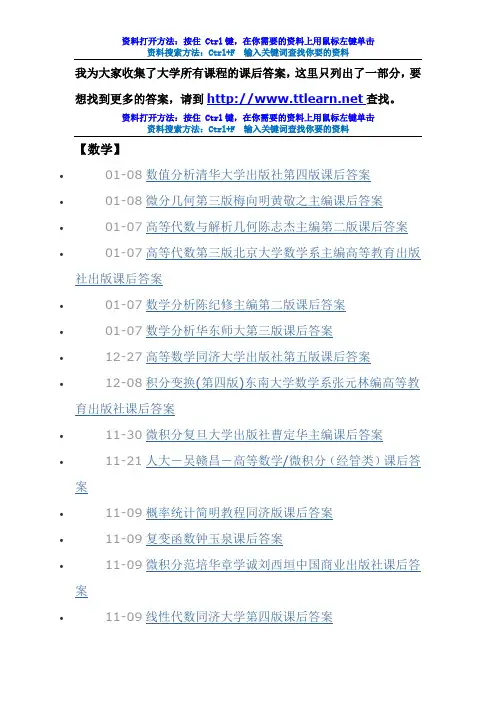
我为大家收集了大学所有课程的课后答案,这里只列出了一部分,要想找到更多的答案,请到查找。
资料打开方法:按住 Ctrl键,在你需要的资料上用鼠标左键单击资料搜索方法:Ctrl+F 输入关键词查找你要的资料【数学】∙01-08数值分析清华大学出版社第四版课后答案∙01-08微分几何第三版梅向明黄敬之主编课后答案∙01-07高等代数与解析几何陈志杰主编第二版课后答案∙01-07高等代数第三版北京大学数学系主编高等教育出版社出版课后答案∙01-07数学分析陈纪修主编第二版课后答案∙01-07数学分析华东师大第三版课后答案∙12-27高等数学同济大学出版社第五版课后答案∙12-08积分变换(第四版)东南大学数学系张元林编高等教育出版社课后答案∙11-30微积分复旦大学出版社曹定华主编课后答案∙11-21人大-吴赣昌-高等数学/微积分(经管类)课后答案∙11-09概率统计简明教程同济版课后答案∙11-09复变函数钟玉泉课后答案∙11-09微积分范培华章学诚刘西垣中国商业出版社课后答案∙11-09线性代数同济大学第四版课后答案∙11-08概率论与数理统计浙大版盛骤谢式千课后答案∙11-08复变函数西安交通大学第四版高等教育出版社课后答案∙11-07离散数学教程肖新攀编著课后习题答案∙11-07离散数学(第三版)清华大学出版社(耿素云,屈婉玲,张立昂)课后习题答案∙11-04高等数学同济大学出版社第六版课后答案∙10-27高等数学北大版课后答案∙【通信/电子/电气/自动化】∙01-08信号与线性系统分析吴大正第4版课后答案∙01-08信号与系统刘泉主编课后答案∙01-08信号与系统奥本海姆英文版课后答案∙01-08数字信号处理吴镇扬高等教育出版社课后答案∙01-08通信原理樊昌信第六版国防大学出版社课后答案∙01-08通信原理北京邮电大学课后答案∙12-10数字逻辑第四版(毛法尧著) 高等教育出版社∙12-10数字逻辑第二版(毛法尧著) 高等教育出版社课后答案∙12-08电路第五版邱关源罗先觉高等教育出版社课后答案∙12-03数字信号处理教程(程佩青第二版) 清华大学出版社课后答案∙12-02数字信号处理教程程佩青(第三版)清华大学出版社课后答案∙11-09模拟电子技术基础童诗白第三版习题答案∙11-09数字电子技术基础阎石第五版课后答案∙11-06信号与系统郑君里主编第二版课后答案∙11-06信号与系统哈工大课后答案∙10-31模拟电子技术基础(第四版童诗白、华成英主编)习题答案∙10-29模拟电路康华光【计算机/网络/信息】∙01-08数据结构(C语言版) 李春葆主编课后答案∙12-05计算机网络教程第五版谢希仁电子工业出版社课后答案∙11-09c程序设计谭浩强主编清华大学出版社习题答案及上机指导∙10-26C语言程序设计教程习题参考答案∙10-26MATLAB程序设计与应用(第二版)刘卫国主编实验答案【经济/金融/营销/管理/电子商务】∙01-06现代西方经济学(宏观)尹伯平主编课后答案∙01-06现代西方经济学(微观经济学) 宋承先主编第3版笔记和课后习题详解∙01-06微观经济学:现代观点范里安主编第5版课后答案∙01-05微观经济学平狄克主编第4和5版笔记和课后习题详解∙01-05宏观经济学曼昆主编第五版课后答案∙01-05宏观经济学多恩布什主编课后习题答案∙01-05企业会计学赵惠芳主编课后答案∙12-05市场调研与预测习题与实例陈启杰上海财经大学出版社课后答案∙11-28西方经济学高鸿业第四版(微观宏观)课后答案∙11-10中级财务会计刘兵初宜红山东人民出版社课后答案∙11-09经济法概论课后答案∙11-08中级财务会计(第二版)刘永泽东北财经大学课后答案【物理/光学/声学/热学/力学】∙01-19机电传动控制华中科技大学出版社邓星钟主编课后答案∙01-05量子力学张永德主编课后答案∙01-04量子力学导论曾谨言著第二版课后答案∙01-04量子力学曾谨言著高等教育出版社第三版第一卷课后答案∙01-04量子力学教程周世勋著高等教育出版社课后答案∙01-04量子力学教程曾谨言著课后答案∙01-04电动力学郭硕鸿主编第三版课后答案∙01-04理论力学卢圣治著课后答案∙01-03理论力学周衍柏著第二版课后答案∙11-09普通物理学程守洙江之咏第五版习题分析与解答∙11-09物理学马文蔚(第五版) 习题分析与解答∙11-09大学基础物理学.2版.清华.张三慧习题答案∙11-06大学物理学赵近芳主编第二版课后答案【土建/机械/车辆/制造/材料】∙01-08机械设计基础(第五版) 高等教育出版社课后答案∙01-07材料力学单辉祖主编课后答案∙01-06材料力学刘鸿文主编哈工大第四版课后答案∙11-11机械原理第六版课后答案【化学/环境/生物/医学/制药】∙01-03高分子化学潘祖仁著第四版课后答案∙01-03物理化学辅导与习题详解第五版傅献彩著∙01-02物理化学南开大学第五版课后答案∙01-02物理化学周亚平天津大学第四版课后答案∙01-02分析化学武汉大学第四版思考题答案∙01-02分析化学武汉大学第四版课后答案∙01-02基础有机化学邢其毅著课后答案∙01-01有机化学莫里森著课后答案∙12-31有机化学(第四版)高鸿宾著课后答案∙12-31有机化学(汪小兰著) 课后答案∙12-31无机化学第三版武汉大学吉林大学编高等教育出版社课后答案∙12-31中级无机化学(朱文祥著) 高等教育出版社课后答案∙12-31无机化学第三版(宋天佑著) 高等教育出版社课后答案∙12-30生物化学解题指导与测验张楚富高等教育出版社课后答案∙12-30生物化学简明教程第四版(张丽萍著) 高等教育出版社课后答案∙12-30生物化学原理(张洪渊著) 科学出版社课后答案∙12-30生物化学第三版(沈同王镜岩著) 高等教育出版社课后答案∙10-31有机化学第三版(胡宏纹著) 高等教育出版社课后答案∙10-29有机化学第四版答案曾昭琼主编高等教育出版社【法学/哲学/心理学/政治学】∙12-29实验心理学杨治良版练习题及答案07年心理学考研∙12-29《心理学》考试题库及答案程素萍浙江大学出版社∙12-29教育心理学第三版(皮连生著) 上海教育出版社课后答案∙12-04毛邓三(2007 华中科技大学版)(毛邓三编写组著) 高等教育出版社课后答案∙11-07毛邓三课后简答题答案∙10-29逻辑学参考答案∙10-26思想道德修养与法律基础罗国杰主编高教版课后答案∙10-26毛泽东思想和中国特色社会主义理论体系概论(吴树青等著) 高等教育出版社课后答案∙10-25马克思主义基本原理概论左伟清华南理工大学出版社课后答案∙10-25毛邓三思考题课后答案【英语/文学/史学/外语/教育】∙01-30step_by_step 2000 第四册听力答案课后答案∙01-30step_by_step 2000 第三册听力答案课后答案∙01-30step_by_step 2000 第二册听力答案课后答案∙01-30step_by_step 2000 第一册听力答案课后答案∙01-09大学体验英语综合教程第四册课后答案及课文翻译∙01-09大学体验英语综合教程第三册课后答案及课文翻译∙01-09大学体验英语综合教程第二册课后答案及课文翻译∙01-09大学体验英语综合教程第一册课后答案及课文翻译∙01-09新视野大学英语第五册课后答案∙01-09新视野大学英语第四册课后答案及课文翻译∙01-09新视野大学英语第三册课后答案及课文翻译∙01-09新视野大学英语第二册课后答案及课文翻译∙01-09新视野大学英语第一册课后答案及课文翻译∙01-05文学理论童庆炳主编修订二版课后答案∙01-05语言学教程胡壮麟主编课后答案[适合背诵]∙11-08中国近代史纲要沙健孙高等教育出版社课后答案∙11-07全新版大学英语综合教程第四册课后答案及课文翻译∙11-07全新版大学英语综合教程第三册课后答案及课文翻译∙11-06全新版大学英语综合教程第二册课后答案及课文翻译∙11-06全新版大学英语综合教程第一册课后答案及课文翻译∙11-06新世纪大学英语综合教程3 课后答案∙11-06新世纪大学英语综合教程2 课后答案∙11-06新世纪大学英语综合教程1 课后答案∙10-25新编大学英语(第一册)习题答案第二版∙10-25新编大学英语(第二册)习题答案∙10-25新编大学英语(第三册)习题答案10-25新编大学英语(第四册)课文翻译及课后习题答案。
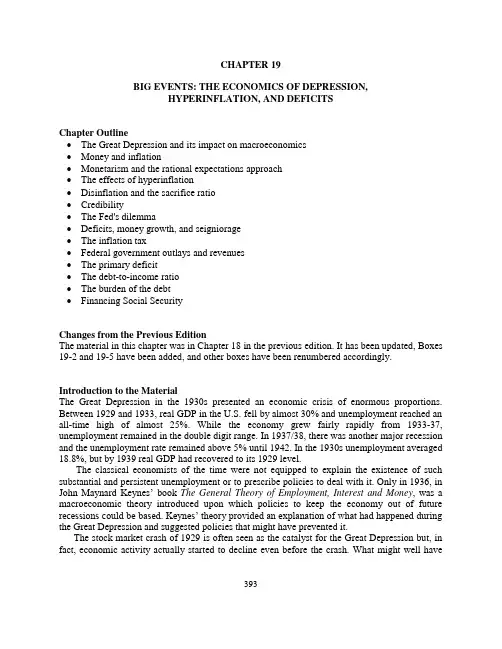
CHAPTER 19BIG EVENTS: THE ECONOMICS OF DEPRESSION,HYPERINFLATION, AND DEFICITSChapter Outline•The Great Depression and its impact on macroeconomics•Money and inflation•Monetarism and the rational expectations approach•The effects of hyperinflation•Disinflation and the sacrifice ratio•Credibility•The Fed's dilemma•Deficits, money growth, and seigniorage•The inflation tax•Federal government outlays and revenues•The primary deficit•The debt-to-income ratio•The burden of the debt•Financing Social SecurityChanges from the Previous EditionThe material in this chapter was in Chapter 18 in the previous edition. It has been updated, Boxes 19-2 and 19-5 have been added, and other boxes have been renumbered accordingly. Introduction to the MaterialThe Great Depression in the 1930s presented an economic crisis of enormous proportions. Between 1929 and 1933, real GDP in the U.S. fell by almost 30% and unemployment reached an all-time high of almost 25%. While the economy grew fairly rapidly from 1933-37, unemployment remained in the double digit range. In 1937/38, there was another major recession and the unemployment rate remained above 5% until 1942. In the 1930s unemployment averaged 18.8%, but by 1939 real GDP had recovered to its 1929 level.The classical economists of the time were not equipped to explain the existence of such substantial and persistent unemployment or to prescribe policies to deal with it. Only in 1936, in John Maynard Keynes’book The General Theory of Employment, Interest and Money, was a macroeconomic theory introduced upon which policies to keep the economy out of future recessions could be based. Keynes’ theory provided an explanation of what had happened during the Great Depression and suggested policies that might have prevented it.The stock market crash of 1929 is often seen as the catalyst for the Great Depression but, in fact, economic activity actually started to decline even before the crash. What might well have393been an average recession turned into a very severe depression due to the inept economic policies employed at the time. The Fed failed to provide needed liquidity to banks and did little to prevent the collapse of the financial system. The huge contraction in money supply due to the large numbers of bank failures caused the economic downturn. Fiscal policy was weak at best. Politicians concerned with balancing the budget raised taxes to match increases in government spending, so the decline in aggregate demand was not counteracted.Many other countries also suffered during the same period, mainly as a result of the collapse of the international financial system and the enactment of high tariffs worldwide. These policies were designed to protect domestic producers in an attempt to improve each country’s domestic trade balance at the expense of foreign trading partners. However, the attempts to "export" unemployment ultimately resulted in an overall decline in world trade and production.In the U.S., many institutional changes and administrative actions, collectively known as the New Deal, were implemented in the 1930s. The Fed was reorganized and new institutions were created, including the FDIC, the SEC, and the Social Security Administration. Public works programs and a program to establish orderly competition among firms were also implemented.The experience of the Great Depression led to the belief that the economy is inherently unstable and active stabilization policy is needed to maintain full employment. Keynes was an advocate of active government policy. In his work, he explained what had happened in the Great Depression and what could be done to avoid a recurrence. Many years later, Milton Friedman and Anna Schwartz offered a different explanation. In their book A Monetary History of the United States, Friedman and Schwartz argued that the severe decline in money supply, caused by the Fed’s failure to prevent banks from failing, was the reason for the severity of the Great Depression. They claimed that monetary policy is very powerful and that fluctuations in money supply can explain most of the fluctuations in GDP over the last century. This argument provided the impetus for new research on the effects of fiscal and monetary stabilization policies. While economists are still debating these issues, we can conclude that monetary policy can affect the behavior of output in the short and medium run, but not in the long run. In the long run, increases in the growth rate of money supply will simply lead to increases in the rate of inflation. Box 19-3 gives an overview of the monetarist positions on the importance of money for the economy, while Box 19-2 quotes Fed Chairman Ben Bernanke, who admits that the magnitude of the Great Depression was indeed the result of the Fed’s action—or, more accurately, inaction.The link between inflation and monetary growth can easily be derived from the quantity theory of money equation:MV = PY ==> %∆M + %∆V = %∆P + %∆Y ==> m + v = π + y ==> π = m - y + v In other words, the rate of inflation (%∆P = π) is determined by the difference between the growth rate of nominal money supply (%∆M = m) and the growth rate of real output (%∆Y = y), adjusted for the percentage change in the income velocity of money (%∆V = v).Figure 19-1 shows that trends in the rate of inflation and the growth of money supply (M2) have been somewhat similar over the last four decades. There is plenty of evidence to support the notion that in the long run, inflation is a monetary phenomenon here in the U.S. as well as in other countries. However, there are short-run variations, indicating that changes in velocity and output growth have also affected the inflation rate. By the mid 1990s, the relationship between394M2 growth and inflation had largely broken down, even for the long run. It is still true, however, that there has never been inflation in the long run without rapid growth of money supply, and the faster money grew the higher the rate of inflation.Although there is no exact definition, countries are said to experience hyperinflation when the inflation rate reaches 1,000% annually. Countries that have experienced hyperinflation have all had huge budget deficits which, in many cases, originated from increased government spending during wartime. A classical example is the German hyperinflation of 1922/23. In an economy experiencing hyperinflation, there is often widespread indexing, most likely to foreign exchange rates rather than to the price level, since prices are changing so fast. Eventually, hyperinflation becomes too much to bear and the government is forced to take harsh measures, including fiscal reform and the introduction of a new monetary unit pegging the new money to a foreign currency. Box 19-4 on the situation in Bolivia in the 1980s provides a good example of how hyperinflation can be stopped. It also points out that the costs are great in terms of decreasing per-capita income. In 1985, Bolivia stopped external debt service, raised taxes, reduced money creation, and stabilized the exchange rate. Inflation came down quickly, but per-capita income in 1989 was 35 percent less than it had been a decade earlier.In its fight against hyperinflation, Israel tried to keep unemployment rates low by instituting wage and price controls while also sharply cutting budget deficits and rationing credit. These measures reduced the rate of inflation significantly. In the late 1980s, the governments of Argentina and Brazil imposed wage-price controls but failed to supplement them with fiscal austerity, so the result was much less satisfactory, although they, like many South American countries eventually succeeded in lowering their inflation rates. In the early 1990s, countries in Eastern Europe experienced brief periods of high inflation during their adjustments from centrally planned economies to more market based economies (as shown in Table 19-6). There is no guarantee that periods of hyperinflation will not surface again. New Box 19-5 describes the situation in Zimbabwe where the decision made in 2006 to print more money to finance higher government spending led to inflation rates in excess of 1,000%.When inflation is high, policy makers must focus on reducing it without causing a major economic downturn. This is fairly difficult to accomplish, however, since labor contracts tend to reflect past expectations and new contract negotiations take time. In addition, it may be difficult for a central bank to gain credibility in its fight against inflation because of its behavior in the past. Credibility is important, since inflationary expectations adjust down faster if people believe that a government is serious in its attempt to reduce inflation. If this is the case, the expectations-adjusted Phillips curve shifts to the left sooner and the economy adjusts more quickly to the full-employment level of output at a lower inflation rate. But some increase in unemployment is almost always needed to reduce inflation, since real wages need to adjust down to their full-employment level. The costs to society are often measured in terms of the sacrifice ratio, that is, the ratio of the cumulative percentage loss of GDP to the achieved reduction in the inflation rate.Probably all economists now agree with the monetarist propositions that rapid money growth tends to be inflationary and inflation cannot be kept low unless money growth is kept low. We also know that monetary policy has long and variable lags. But other monetarist positions remain more controversial, including those that suggest that the economy is inherently stable and that monetary targets are better than interest rate targets. The rational expectations approach can be seen as an extension of the monetarist approach, with a strong belief that markets clear rapidly395and people use all information available to them. This is why they advocate policy rules rather than discretion and place emphasis on the credibility of policy makers. Box 19-6 highlights the rational expectations approach.Any government that is unwilling to show fiscal restraint will ultimately be faced with excessive money growth and an increase in the inflation rate. Continued large government budget deficits create a policy dilemma for a central bank, which must decide whether to monetize the debt. If the central bank decides not to finance the debt, the increased borrowing needs of the government may drive interest rates up, leading to the crowding out of private spending. The central bank may then be blamed for slowing down economic growth. But if the central bank is worried about high interest rates and monetizes the debt in order to keep interest rates low, inflation may increase with the central bank taking the blame.The financing of government spending through the creation of high-powered money is an alternative to explicit taxation. Inflation acts like a tax since the government can spend more by printing money while people can spend less, since some of their income must be used to increase their nominal money holdings. The inflation tax revenue is defined as:inflation tax revenue = (inflation rate)*(the real money base).The ability of the government to raise additional tax revenue through the creation of money (and therefore inflation) is called seigniorage, and Table 19-7 shows some empirical evidence of the inflation tax revenue raised as percentage of GDP for some Latin American countries. However, there is a limit to how much revenue a government can raise through an inflation tax. As inflation increases, people reduce their currency holdings and banks reduce their excess reserves, since holding money becomes more costly. Eventually the real monetary base falls so much that the government's inflation tax revenue decreases. Figure 19-3 shows this graphically.While higher deficits can cause higher inflation if they are financed through money creation, higher inflation may also contribute to deficits, since inflation reduces the real value of tax payments. In addition, high nominal interest rates (caused by high inflation) raise the nominal interest payments the government must make on the national debt. The inflation-adjusted deficit corrects for that and is defined in the following way:inflation-adjusted deficit = total deficit - (inflation rate)*(national debt).Large government budget deficits and rapid monetary expansion seem to be inevitable parts of hyperinflation. The high rate of monetary expansion originates in the government's desire to raise its inflation tax revenue. However, the government can only be successful if it prints money faster than the public anticipates. Eventually, the process will break down, as the real money base becomes smaller and smaller.During the 1980s, the U.S. experienced very large budget deficits, which were temporarily brought under control in the late 1990s, only to increase sharply again in 2002. Figure 19-4 shows the trend in U.S. budget deficits as percentage of GDP, while Tables 19-8 and 19-9 give an overview of trends in the U.S. government's outlays and revenues. It is interesting to note that entitlements and interest payments on the national debt have increased significantly over the last396four decades. On the revenue side, corporate income taxes as a share of GDP have declined, while social insurance taxes have increased substantially.To highlight the role of the national debt in the budget, it is useful to distinguish between the actual budget deficit and the primary (non-interest) budget deficit. The U.S. budget deficits in the 1990s were actually more a result of high interest payments on the previously incurred debt than of government spending exceeding tax revenues. This is the legacy of past deficits. As the national debt accumulates, its interest costs accelerate, contributing even more to the budget deficit. The national debt is the result of all past and present budget deficits, and the process by which the Treasury finances the debt is called debt management. As old government securities mature, the Treasury issues new securities to make the payments on old ones.Robert Eisner has argued that it is important to recognize that the government has assets and not just debts. Any spending on infrastructure should be treated as accumulation of real capital and offset by the debt issued to pay for it. In other words, just like private spending, government expenditures should be separated into government “consumption” and government “investment.”With the U.S. gross national debt now exceeding $8.5 trillion (or over $28,000 per capita), it becomes important to consider its real burden. If individuals who hold government bonds consider an increase in government debt as an increase in their personal wealth, they will consume more and a lower share of GDP will be invested. This will lead to a lower rate of capital accumulation and slower future economic growth. Another concern is that foreigners hold a large part of the debt. Since the burden of future tax payments on this part of the debt (plus interest) will fall on U.S. taxpayers while the recipients of these payments will be foreigners, there will be a reduction in U.S. net wealth.High deficits cannot be sustained indefinitely, but as long as national income is growing faster than the national debt (implying a declining debt-income ratio), the potential for instability is fairly low. In the 1990s, there was widespread sentiment that government had grown too big and that sound fiscal policy had to be implemented. The fiscal restriction finally succeeded in turning the large budget deficits of the 1980s into budget surpluses in 1998. A debate quickly began among politicians about the best ways to put the surplus to use. Was it better to cut taxes, increase spending, or gradually pay off the national debt? The path chosen by the Bush administration was a massive tax cut, leading to renewed budget deficits in 2002.Another debate revolves around Social Security reform. There is increasing concern about the financial difficulties that the Social Security system will face in the near future. The system is financed to a large extent on a pay-as-you-go basis, with most of the earmarked taxes paid by current workers being used immediately to finance the Social Security benefits of current retirees. Such a transfer of resources from the young to the old can be accomplished if:• A growing population increases the ratio of workers to retirees. If population growth slows, however, then contributions have to be increased or benefits have to be cut.•High-income growth allows retirement benefits to be higher than past contributions, since the source of the benefits is the higher income of the younger generations. If income growth slows, however, then the system may face financing difficulties.•The political situation is favorable. A larger percentage of older people than younger people vote so the elderly can enforce the intergenerational transfer through the political system. But at some point, the young, who expect to receive lower benefits than their parents relative to their contributions, may refuse to support the system through their taxes.397While the Social Security system is often seen as a “forced savings system,” which makes sure that everyone accumulates some wealth for retirement, there is strong empirical evidence that the system actually reduces national saving due to its pay-as-you-go financing. The decline in saving reduces the rate of capital accumulation, which lowers productivity and future living standards.The Social Security trust fund actually has been growing as a result of the Social Security Reform of 1983, but current predictions are that the system will be bankrupt after 2045 when most of the baby-boomer generation will have retired. While most people do not wish to see the Social Security system totally abandoned, additional reforms are very likely in the near future. The central question is how to earn higher returns on the funds invested to prevent the system from insolvency and how to preserve equity for those who have already paid into the system. Suggestions for LecturingStudents who follow the news see stock prices fluctuate daily and they probably heard about past stock market bubbles and crashes. These students will be curious about the impact of major swings in stock market activity on the economy. Most people assume that the stock market crash of October, 1929 marked the beginning of the Great Depression and are not aware that economic activity had actually begun to decline earlier. A good way to introduce the material in this chapter is to ask: “Could a Great Depression happen again?” or “Do stock market crashes cause economic downturns?” Either will lead to a lively class discussion that can help to highlight several of the issues raised in the chapter. In this discussion the major stock market crash of October, 1987 and the decline in (especially high-tech) stock values that started in March, 2000 will undoubtedly come up. They are reminders that stock market bubbles will always eventually burst and that there is considerable risk associated with buying stocks.Most economists now agree that the magnitude of the Great Depression was exacerbated by inadequate fiscal and monetary policy responses. The Fed’s failure to inject e nough liquidity into the banking system to prevent failures led to a severe contraction in the supply of money and an economic downturn, and. Policy makers also did little initially to stimulate economic activity through fiscal policy. The severity of the economic situation in the 1930’s is not surprising to economists today, as no well-developed economic theory existed at the time that could deal with a disturbance of this magnitude. It was not until John Maynard Keynes offered an explanation of what had happened during the Great Depression and suggested ways to prevent future recessions that macroeconomists began to ponder the values of fiscal and monetary stabilization policies. It is no wonder that Keynes is seen by many as the “father of all macroeconomists.”Economic theories are generally pro ducts of their time and, as mentioned above, Keynes’macroeconomic theory was developed as a result of the Great Depression. His explanation and prescription for preventing future depressions were widely accepted, but did not have much impact on policy making in the U.S. until the 1960s, when the government followed (mostly fiscal) activist policies to ensure full employment.The handling of the major stock market crash of 1987 appears to indicate that policy makers have learned from past mistakes. Stock values dropped by more than 24% in October of 1987, but we did we not see a severe downturn in economic activity. Why not? For one, Alan398Greenspan, who had been appointed as chair of the Board of Governors of the Fed only a few months earlier, was conscious of what had happened in 1929 and immediately assured financial markets that the Fed would provide the liquidity needed to prevent a financial collapse. The Fed quickly started to undertake open market purchases in an effort to drive interest rates down. In addition, as a result of institutional changes implemented after the Great Depression, government now has a much larger role in the economy. Students should be aware that the Great Depression not only shaped modern macroeconomic thinking and approaches to stabilization policy, but also shaped the structure of many U.S. institutions. Instructors may want to spend some time talking about these institutions and their importance to our economy.It also should be noted that the economy was in much better shape when the stock market crashed in 1987 than it was in 1929. While we can only speculate on what would have happened had the economy been in worse shape, the existence of programs such as Social Security and unemployment insurance would have dampened the severity of a downturn by providing some automatic stability. In addition, the existence of the FDIC, which insures all bank deposits up to $100,000, now serves to avoid panic in financial markets and runs on banks.The recession in 1981/82, which was the most severe recession since the Great Depression and brought the unemployment level close to 11%, provides another good example that policy makers now react much more swiftly to major economic upheavals. Even though the recession was fairly severe, it did not last for an extended period, since expansionary policies were implemented almost immediately after the magnitude of the downturn became clear.There are still disagreements about the primary causes for the Great Depression and these should be clarified. The Keynesian explanation concentrates on spending behavior, that is, the reduction in consumption and the collapse of investment. The decrease in aggregate demand was exacerbated by the restrictive fiscal policy implemented by the government trying to balance the budget. The monetarist explanation concentrates on the behavior of money and asserts that the Fed failed to prevent the collapse of the banking system. The large number of bank failures led to a loss of confidence in the banking system, an enormous increase in the currency-deposit ratio, and therefore a huge decrease in the money multiplier. Monetarists see the resulting severe decline in money supply as the cause of the Great Depression. Both explanations fit the facts and it is important for instructors to point out that there is no inherent conflict between them; in fact, they complement one another.While the programs of the New Deal are largely credited with revitalizing the economy in the mid-1930s, probably one of the most important factors was the sharp increase in money supply, starting in 1933. This is often a forgotten fact. It should be noted that while unemployment remained high, the deflation of prices and wages stopped after 1933, and output began to rebound. In addition, some of the programs implemented by the government after the Great Depression helped to keep wages from falling further.The fact that unemployment’s downward pressure on wages tends to weaken if high unemployment is persistent should also be mentioned at this point. The possibility that the behavior of nominal wages affects the rate of inflation should be discussed with reference to the situation in some European countries, where the unemployment rate has been above the levels experienced in the U.S. for quite some time.The German hyperinflation of 1922-23, when the inflation rate averaged 322% per month, provides another example of a major economic event that shaped macroeconomic thinking. But399students will probably prefer to discuss more recent examples, such as the Bolivian experience of the 1980s highlighted in Box 19-4 or the situation in Zimbabwe starting in 2006. Both cases make clear that the cost of stopping hyperinflation can be extremely high in terms of a decreased standard of living. The discussion should make it clear that large budget deficits and rapid monetary growth are always prevalent in times of hyperinflation, and only draconian measures can ensure a reduction in inflationary expectations. Without such measures the economy will collapse and has to be completely restructured, with the introduction of a new monetary unit that may be pegged to a foreign exchange rate.There is no exact definition of hyperinflation, but it is said to exist when the inflation rate reaches 1,000% on an annual basis. Students will always remember the following definition of inflation in general: “inflation is nothing more than too much money chasing too few goods.” But is inflation “always and everywhere a monetary phenomenon,” as Milton Friedman put it? Figure 19-1 indicates that the rate of inflation and the growth rate of M2 show somewhat similar long-run trends (at least until about 1993), but there are large variations in the short run. In other words, the link between monetary growth and the inflation rate is by no means precise. For one, growth in output affects the inflation rate and real money holdings. Interest rate changes and financial innovations also affect desired money holdings and therefore the income velocity of money. Empirical evidence indicates that the velocity of M2 has shown a fairly constant long-run trend from the 1960s to the 1990s, while the velocity of M1 has fluctuated significantly over the last few decades. Considering the enormous changes that took place in the U.S. banking system in the 1980s, it is surprising that the income velocity of M2 actually stayed as stable as it did. By the late 1990s, the link between M2 growth and the inflation rate had largely broken down; the possible causes and any monetary policy implications should be discussed.By now, students should be familiar with the quantity theory of money equation and should be able to derive the equation that shows the long-run relationship between money growth, output growth, velocity changes, and the rate of inflation. We can thus derive the following:MV = PY ==> %∆M + %∆V = %∆P + %∆Y ==> %∆P = %∆M - %∆Y + %∆V==> π = m - y + v.This equation indicates that higher growth rates of money (%∆M = m) adjusted for growth in output (%∆Y = y) and changes in velocity (%∆V = v) are associated with higher inflation rates (%∆P = π). The strict monetary growth rule is based on this equation and suggests that a zero inflation rate can be achieved if money supply is only allowed to grow at the same rate as the long-run trend of output, assuming that velocity remains stable. It should be made clear, that this equation shows only a long-run relationship and that output growth and velocity can be highly variable in the short run, causing great variations in the inflation rate.Besides looking at the role of monetary growth in determining the inflation rate, instructors may also want to spend some time looking at the role of nominal wages and labor productivity. Just by recalling the simple equationw = W/P,400。
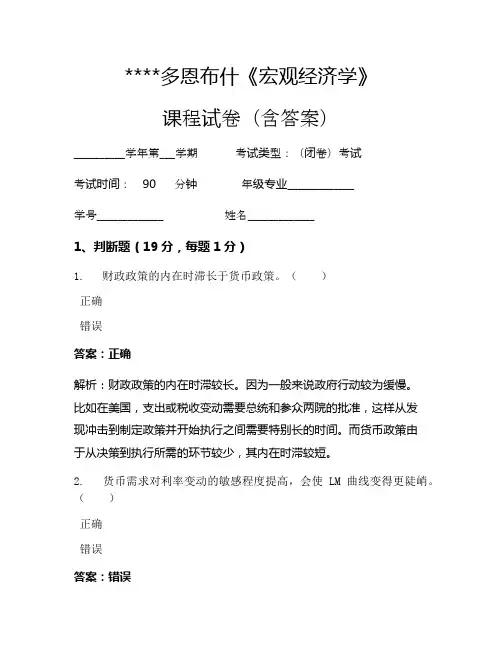
****多恩布什《宏观经济学》课程试卷(含答案)__________学年第___学期考试类型:(闭卷)考试考试时间:90 分钟年级专业_____________学号_____________ 姓名_____________1、判断题(19分,每题1分)1. 财政政策的内在时滞长于货币政策。
()正确错误答案:正确解析:财政政策的内在时滞较长。
因为一般来说政府行动较为缓慢。
比如在美国,支出或税收变动需要总统和参众两院的批准,这样从发现冲击到制定政策并开始执行之间需要特别长的时间。
而货币政策由于从决策到执行所需的环节较少,其内在时滞较短。
2. 货币需求对利率变动的敏感程度提高,会使LM曲线变得更陡峭。
()正确错误答案:错误解析:货币需求对利率的敏感系数h越大,LM曲线的斜率k/h越小,因此LM曲线越平缓。
3. 通胀会扭曲银行储蓄,因为人们缴纳的是名义所得税而不是实际所得税。
()正确错误答案:正确解析:存在通胀的前提下,储蓄的机会成本就是物价上涨的水平,因此人们缴纳的所得税考虑了通货膨胀的因素,属于名义所得税。
4. 在20世纪70年代和80年代,菲利普斯曲线向外移动,使得在相对比较低的通货膨胀率水平上降低失业更为容易。
()正确错误答案:错误解析:菲利普斯曲线向外移动表示在相对较高的通货膨胀水平上降低失业比较容易。
5. 如果相对购买力平价成立,那么通货膨胀率高的国家将会导致该国货币贬值。
()正确错误答案:正确解析:相对购买力平价的关系方程为:∆ε/ε=πf-π,即名义汇率的增长率=国外通货膨胀率-国内通货膨胀率。
因此,若相对购买力平价成立,通货膨胀率较高的国家,货币将贬值。
6. 浮动汇率下,货币政策的传导机制不同于封闭经济,前者通过改变汇率、后者通过改变利率来影响收入。
()正确错误答案:正确解析:开放经济下,货币政策的传导机制是通过货币供给变动改变汇率,通过汇率来影响进出口,进而影响国民收入。
而封闭经济下,货币政策只能影响利率,通过利率影响收入水平。
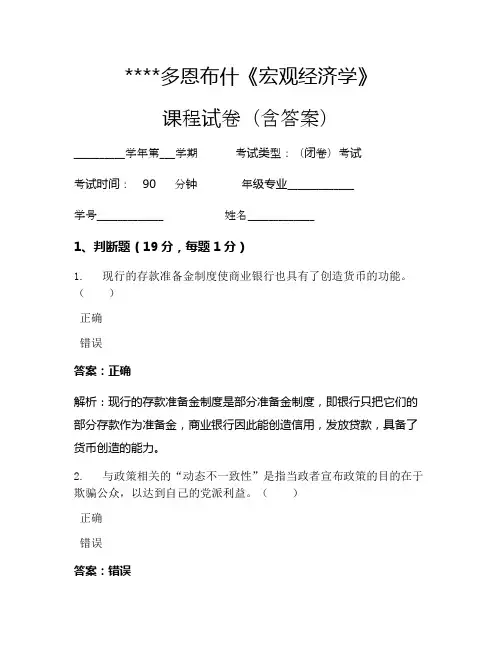
****多恩布什《宏观经济学》课程试卷(含答案)__________学年第___学期考试类型:(闭卷)考试考试时间:90 分钟年级专业_____________学号_____________ 姓名_____________1、判断题(19分,每题1分)1. 现行的存款准备金制度使商业银行也具有了创造货币的功能。
()正确错误答案:正确解析:现行的存款准备金制度是部分准备金制度,即银行只把它们的部分存款作为准备金,商业银行因此能创造信用,发放贷款,具备了货币创造的能力。
2. 与政策相关的“动态不一致性”是指当政者宣布政策的目的在于欺骗公众,以达到自己的党派利益。
()正确错误答案:错误解析:与政策相关的政策的“动态不一致性”其目的在于欺骗公众,以优化公众利益。
3. 如果相对购买力平价成立,那么通货膨胀率高的国家将会导致该国货币贬值。
()正确错误答案:正确解析:相对购买力平价的关系方程为:∆ε/ε=πf-π,即名义汇率的增长率=国外通货膨胀率-国内通货膨胀率。
因此,若相对购买力平价成立,通货膨胀率较高的国家,货币将贬值。
4. 当期物价水平不仅受当期货币供给量的影响,而且还与未来货币供给量预期相关。
()正确错误答案:正确解析:如果预期未来货币供给量增加(或减少),则现期的物品将会升值(贬值),相应的价格将相对较低(高),现期价格将会上升(或减少)。
所以,当期物价水平不仅受当期货币供给量的影响,而且还与未来货币供给量预期相关。
5. 由购买力平价理论可知,按国外产品每单位美国产品衡量的名义汇率等于国内价格水平除以国外价格水平。
()错误答案:错误解析:按国外产品每单位美国产品衡量的名义汇率等于实际汇率与价格水平的比率。
6. 根据内生经济增长模型,投资可以导致一国的长期增长。
()正确错误答案:正确解析:内生增长模型中,投资和储蓄都可以导致经济的持续增长。
7. 菲利普斯曲线表述的关系表明治理通货膨胀最有力的措施是工资和物价管制。

****多恩布什《宏观经济学》课程试卷(含答案)__________学年第___学期考试类型:(闭卷)考试考试时间:90 分钟年级专业_____________学号_____________ 姓名_____________1、判断题(19分,每题1分)1. 总供给曲线向右上方倾斜意味着产量与其自然率的背离与物价与其预期水平的背离负相关。
()正确错误答案:错误解析:总供给曲线向右上方倾斜表示当物价水平背离了人们预期的物价水平时,供给量就背离了其长期水平或“自然水平”。
当物价水平高于预期水平时,产量就高于其自然率。
当物价水平低于预期水平时,产量就低于其自然率。
因此,产量与其自然率的背离与物价与其预期水平的背离正相关。
2. 在LM曲线不变的情况下,IS曲线越平坦,则财政政策的效果越差。
()正确错误答案:正确解析:在LM曲线不变的情况下,IS曲线越平坦,挤出效应就越大,财政政策效果就越差。
如图12-1所示。
图12-1 财政政策效果因IS斜率而异3. 如果货币供应减少,总需求曲线左移。
()正确错误答案:正确解析:货币供给减少,则利率上升,投资减少,总需求减少,从而总需求曲线左移。
4. 在货币需求完全取决于收入的古典情形下,财政政策的乘数为0。
()正确错误答案:正确解析:当货币需求完全取决于收入时,LM曲线为垂直线,当政府支出增加时,国民收入不变,如图10-1所示,即财政支出不能带来国民收入的变化,财政政策乘数为0。
图10-1 古典主义情形下财政政策效果5. 根据现值现金流分析,企业是否投资取决于净现值是否大于1。
()正确错误答案:错误解析:当企业的净现值大于零时,企业进行投资;而企业净现值为负数时,则减少投资。
因此企业是否投资取决于净现值的正负,而非是否大于1。
6. 未来一笔资金的现值是在当前利率水平下,产生未来资金数量所需的当前资金数量。
()正确错误答案:正确解析:任何一种未来价值的现值是按现行利率折算的一定量未来价值的现在价值。
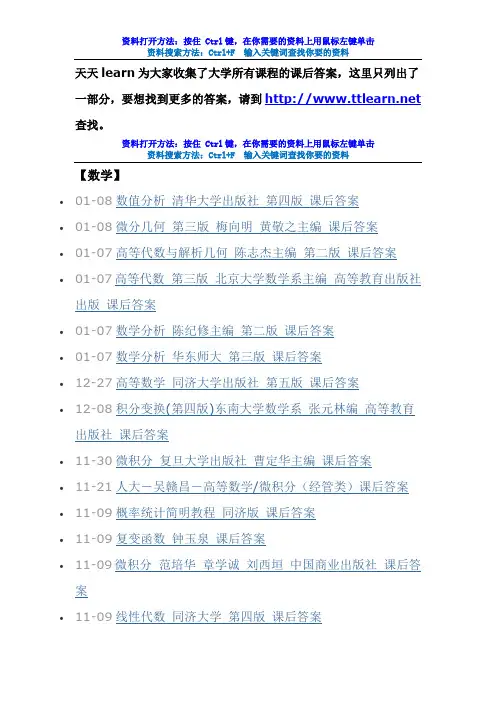
天天learn为大家收集了大学所有课程的课后答案,这里只列出了一部分,要想找到更多的答案,请到 查找。
资料打开方法:按住 Ctrl键,在你需要的资料上用鼠标左键单击资料搜索方法:Ctrl+F 输入关键词查找你要的资料【数学】∙01-08数值分析清华大学出版社第四版课后答案∙01-08微分几何第三版梅向明黄敬之主编课后答案∙01-07高等代数与解析几何陈志杰主编第二版课后答案∙01-07高等代数第三版北京大学数学系主编高等教育出版社出版课后答案∙01-07数学分析陈纪修主编第二版课后答案∙01-07数学分析华东师大第三版课后答案∙12-27高等数学同济大学出版社第五版课后答案∙12-08积分变换(第四版)东南大学数学系张元林编高等教育出版社课后答案∙11-30微积分复旦大学出版社曹定华主编课后答案∙11-21人大-吴赣昌-高等数学/微积分(经管类)课后答案∙11-09概率统计简明教程同济版课后答案∙11-09复变函数钟玉泉课后答案∙11-09微积分范培华章学诚刘西垣中国商业出版社课后答案∙11-09线性代数同济大学第四版课后答案∙11-08概率论与数理统计浙大版盛骤谢式千课后答案∙11-08复变函数西安交通大学第四版高等教育出版社课后答案∙11-07离散数学教程肖新攀编著课后习题答案∙11-07离散数学(第三版)清华大学出版社(耿素云,屈婉玲,张立昂)课后习题答案∙11-04高等数学同济大学出版社第六版课后答案∙10-27高等数学北大版课后答案∙【通信/电子/电气/自动化】∙01-08信号与线性系统分析吴大正第4版课后答案∙01-08信号与系统刘泉主编课后答案∙01-08信号与系统奥本海姆英文版课后答案∙01-08数字信号处理吴镇扬高等教育出版社课后答案∙01-08通信原理樊昌信第六版国防大学出版社课后答案∙01-08通信原理北京邮电大学课后答案∙12-10数字逻辑第四版(毛法尧著) 高等教育出版社∙12-10数字逻辑第二版(毛法尧著) 高等教育出版社课后答案∙12-08电路第五版邱关源罗先觉高等教育出版社课后答案∙12-03数字信号处理教程(程佩青第二版) 清华大学出版社课后答案∙12-02数字信号处理教程程佩青(第三版)清华大学出版社课后答案∙11-09模拟电子技术基础童诗白第三版习题答案∙11-09数字电子技术基础阎石第五版课后答案∙11-06信号与系统郑君里主编第二版课后答案∙11-06信号与系统哈工大课后答案∙10-31模拟电子技术基础(第四版童诗白、华成英主编)习题答案∙10-29模拟电路康华光【计算机/网络/信息】∙01-08数据结构(C语言版) 李春葆主编课后答案∙12-05计算机网络教程第五版谢希仁电子工业出版社课后答案∙11-09c程序设计谭浩强主编清华大学出版社习题答案及上机指导∙10-26C语言程序设计教程习题参考答案∙10-26MATLAB程序设计与应用(第二版)刘卫国主编实验答案【经济/金融/营销/管理/电子商务】∙01-06现代西方经济学(宏观)尹伯平主编课后答案∙01-06现代西方经济学(微观经济学) 宋承先主编第3版笔记和课后习题详解∙01-06微观经济学:现代观点范里安主编第5版课后答案∙01-05微观经济学平狄克主编第4和5版笔记和课后习题详解∙01-05宏观经济学曼昆主编第五版课后答案∙01-05宏观经济学多恩布什主编课后习题答案∙01-05企业会计学赵惠芳主编课后答案∙12-05市场调研与预测习题与实例陈启杰上海财经大学出版社课后答案∙11-28西方经济学高鸿业第四版(微观宏观)课后答案∙11-10中级财务会计刘兵初宜红山东人民出版社课后答案∙11-09经济法概论课后答案∙11-08中级财务会计(第二版)刘永泽东北财经大学课后答案【物理/光学/声学/热学/力学】∙01-19机电传动控制华中科技大学出版社邓星钟主编课后答案∙01-05量子力学张永德主编课后答案∙01-04量子力学导论曾谨言著第二版课后答案∙01-04量子力学曾谨言著高等教育出版社第三版第一卷课后答案∙01-04量子力学教程周世勋著高等教育出版社课后答案∙01-04量子力学教程曾谨言著课后答案∙01-04电动力学郭硕鸿主编第三版课后答案∙01-04理论力学卢圣治著课后答案∙01-03理论力学周衍柏著第二版课后答案∙11-09普通物理学程守洙江之咏第五版习题分析与解答∙11-09物理学马文蔚(第五版) 习题分析与解答∙11-09大学基础物理学.2版.清华.张三慧习题答案∙11-06大学物理学赵近芳主编第二版课后答案【土建/机械/车辆/制造/材料】∙01-08机械设计基础(第五版) 高等教育出版社课后答案∙01-07材料力学单辉祖主编课后答案∙01-06材料力学刘鸿文主编哈工大第四版课后答案∙11-11机械原理第六版课后答案【化学/环境/生物/医学/制药】∙01-03高分子化学潘祖仁著第四版课后答案∙01-03物理化学辅导与习题详解第五版傅献彩著∙01-02物理化学南开大学第五版课后答案∙01-02物理化学周亚平天津大学第四版课后答案∙01-02分析化学武汉大学第四版思考题答案∙01-02分析化学武汉大学第四版课后答案∙01-02基础有机化学邢其毅著课后答案∙01-01有机化学莫里森著课后答案∙12-31有机化学(第四版)高鸿宾著课后答案∙12-31有机化学(汪小兰著) 课后答案∙12-31无机化学第三版武汉大学吉林大学编高等教育出版社课后答案∙12-31中级无机化学(朱文祥著) 高等教育出版社课后答案∙12-31无机化学第三版(宋天佑著) 高等教育出版社课后答案∙12-30生物化学解题指导与测验张楚富高等教育出版社课后答案∙12-30生物化学简明教程第四版(张丽萍著) 高等教育出版社课后答案∙12-30生物化学原理(张洪渊著) 科学出版社课后答案∙12-30生物化学第三版(沈同王镜岩著) 高等教育出版社课后答案∙10-31有机化学第三版(胡宏纹著) 高等教育出版社课后答案∙10-29有机化学第四版答案曾昭琼主编高等教育出版社【法学/哲学/心理学/政治学】∙12-29实验心理学杨治良版练习题及答案07年心理学考研∙12-29《心理学》考试题库及答案程素萍浙江大学出版社∙12-29教育心理学第三版(皮连生著) 上海教育出版社课后答案∙12-04毛邓三(2007 华中科技大学版)(毛邓三编写组著) 高等教育出版社课后答案∙11-07毛邓三课后简答题答案∙10-29逻辑学参考答案∙10-26思想道德修养与法律基础罗国杰主编高教版课后答案∙10-26毛泽东思想和中国特色社会主义理论体系概论(吴树青等著) 高等教育出版社课后答案∙10-25马克思主义基本原理概论左伟清华南理工大学出版社课后答案∙10-25毛邓三思考题课后答案【英语/文学/史学/外语/教育】∙01-30step_by_step 2000 第四册听力答案课后答案∙01-30step_by_step 2000 第三册听力答案课后答案∙01-30step_by_step 2000 第二册听力答案课后答案∙01-30step_by_step 2000 第一册听力答案课后答案∙01-09大学体验英语综合教程第四册课后答案及课文翻译∙01-09大学体验英语综合教程第三册课后答案及课文翻译∙01-09大学体验英语综合教程第二册课后答案及课文翻译∙01-09大学体验英语综合教程第一册课后答案及课文翻译∙01-09新视野大学英语第五册课后答案∙01-09新视野大学英语第四册课后答案及课文翻译∙01-09新视野大学英语第三册课后答案及课文翻译∙01-09新视野大学英语第二册课后答案及课文翻译∙01-09新视野大学英语第一册课后答案及课文翻译∙01-05文学理论童庆炳主编修订二版课后答案∙01-05语言学教程胡壮麟主编课后答案[适合背诵]∙11-08中国近代史纲要沙健孙高等教育出版社课后答案∙11-07全新版大学英语综合教程第四册课后答案及课文翻译∙11-07全新版大学英语综合教程第三册课后答案及课文翻译∙11-06全新版大学英语综合教程第二册课后答案及课文翻译∙11-06全新版大学英语综合教程第一册课后答案及课文翻译∙11-06新世纪大学英语综合教程3 课后答案∙11-06新世纪大学英语综合教程2 课后答案∙11-06新世纪大学英语综合教程1 课后答案∙10-25新编大学英语(第一册)习题答案第二版∙10-25新编大学英语(第二册)习题答案∙10-25新编大学英语(第三册)习题答案∙10-25新编大学英语(第四册)课文翻译及课后习题答案。

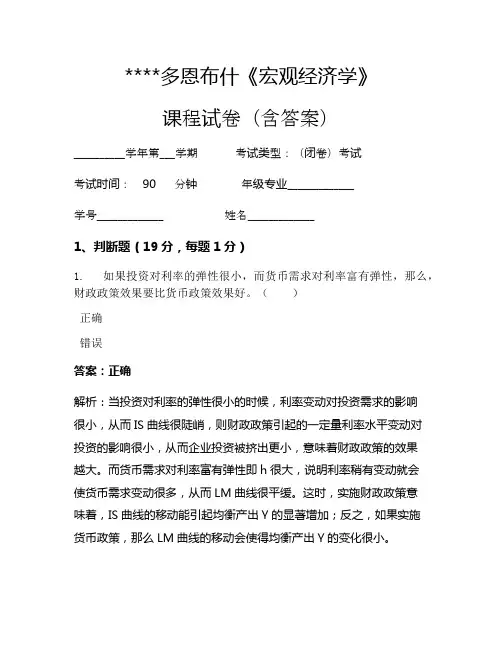
****多恩布什《宏观经济学》课程试卷(含答案)__________学年第___学期考试类型:(闭卷)考试考试时间:90 分钟年级专业_____________学号_____________ 姓名_____________1、判断题(19分,每题1分)1. 如果投资对利率的弹性很小,而货币需求对利率富有弹性,那么,财政政策效果要比货币政策效果好。
()正确错误答案:正确解析:当投资对利率的弹性很小的时候,利率变动对投资需求的影响很小,从而IS曲线很陡峭,则财政政策引起的一定量利率水平变动对投资的影响很小,从而企业投资被挤出更小,意味着财政政策的效果越大。
而货币需求对利率富有弹性即h很大,说明利率稍有变动就会使货币需求变动很多,从而LM曲线很平缓。
这时,实施财政政策意味着,IS曲线的移动能引起均衡产出Y的显著增加;反之,如果实施货币政策,那么LM曲线的移动会使得均衡产出Y的变化很小。
2. 政府支出的变化直接影响总需求,但税收和转移支付则是通过它们对私人消费和投资的影响间接影响总需求。
()正确错误答案:正确解析:从三部门国民收入决定模型可以看出,政府支出G直接作用于国民收入,而税收和转移支付首先影响个人的可支配收入,然后影响消费和投资决策,对国民收入产生间接影响。
3. 在开放经济中,对可贷资金的需求来自国内投资和资本净流出。
()正确错误答案:正确解析:在开放经济中,对可贷资金的需求既来自国内需求又来自国外需求,国内需求表现为国内投资,国外需求表现为资本净流出。
4. 一国出现经常项目赤字意味着该国的经济出现衰退。
()正确错误答案:错误解析:实际经常项目差额等于实际国民储蓄减去国内净投资余额,因此,经常项目赤字可能是由于较高的国内净投资余额导致的,这并不意味着经济出现衰退。
5. 根据黏性工资模型,总供给曲线之所以向右上方倾斜,是因为使利润上涨的事件并不都会使工资上涨。
()正确错误答案:正确解析:在黏性工资模型中,在短期内假设劳动市场失灵,名义工资具有黏性,不能随劳动的供求状况立即调整。
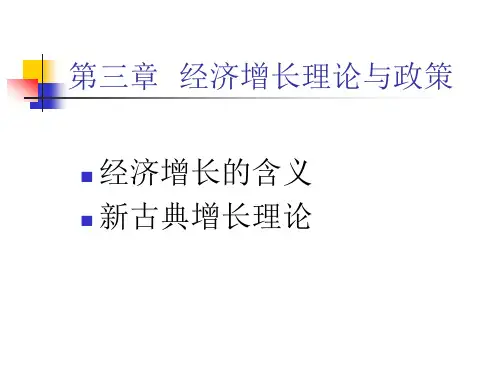
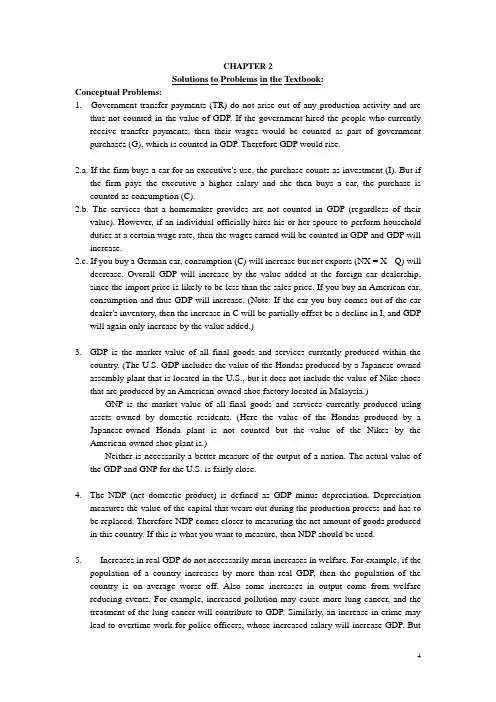
CHAPTER 2Solutions to Problems in the Textbook:Conceptual Problems:1. Government transfer payments (TR) do not arise out of any production activity and arethus not counted in the value of GDP. If the government hired the people who currently receive transfer payments, then their wages would be counted as part of government purchases (G), which is counted in GDP. Therefore GDP would rise.2.a. If the firm buys a car for an executive's use, the purchase counts as investment (I). But ifthe firm pays the executive a higher salary and she then buys a car, the purchase is counted as consumption (C).2.b. The services that a homemaker provides are not counted in GDP (regardless of theirvalue). However, if an individual officially hires his or her spouse to perform household duties at a certain wage rate, then the wages earned will be counted in GDP and GDP will increase.2.c. If you buy a German car, consumption (C) will increase but net exports (NX = X - Q) willdecrease. Overall GDP will increase by the value added at the foreign car dealership, since the import price is likely to be less than the sales price. If you buy an American car, consumption and thus GDP will increase. (Note: If the car you buy comes out of the car dealer's inventory, then the increase in C will be partially offset be a decline in I, and GDP will again only increase by the value added.)3. GDP is the market value of all final goods and services currently produced within thecountry. (The U.S. GDP includes the value of the Hondas produced by a Japanese-owned assembly plant that is located in the U.S., but it does not include the value of Nike shoes that are produced by an American-owned shoe factory located in Malaysia.) GNP is the market value of all final goods and services currently produced using assets owned by domestic residents. (Here the value of the Hondas produced by a Japanese-owned Honda plant is not counted but the value of the Nikes by the American-owned shoe plant is.)Neither is necessarily a better measure of the output of a nation. The actual value of the GDP and GNP for the U.S. is fairly close.4. The NDP (net domestic product) is defined as GDP minus depreciation. Depreciationmeasures the value of the capital that wears out during the production process and has to be replaced. Therefore NDP comes closer to measuring the net amount of goods produced in this country. If this is what you want to measure, then NDP should be used.5. Increases in real GDP do not necessarily mean increases in welfare. For example, if thepopulation of a country increases by more than real GDP, then the population of the country is on average worse off. Also some increases in output come from welfare reducing events. For example, increased pollution may cause more lung cancer, and the treatment of the lung cancer will contribute to GDP. Similarly, an increase in crime may lead to overtime work for police officers, whose increased salary will increase GDP. Butthe welfare of the people in the country may not have increased in either case. On the other hand, GDP does not always accurately measure quality improvements in goods or services (faster computers or improved health care) that improve people's welfare.6. The CPI (consumer price index) and the PPI (producer price index) are both measuredby looking at a certain market basket. The CPI's basket contains mostly finished goods and services that consumers tend to buy regularly in their daily lives. The PPI’s basket contains raw materials and semi-finished goods, that is, it measures costs to the producer of a product and its first user. The CPI is a concurrent economic indicator, whereas the PPI is a leading economic indicator.7. The GDP-deflator is a price index that covers the average price increase of all final goodsand services currently produced within an economy. It is defined as the ratio of current nominal GDP to current real GDP. Nominal GDP is measured in current dollars, while real GDP is measured in so-called base-year dollars. Even though early estimates of the GDP-deflator tend to be unreliable, the GDP-deflator can be a more useful price index than the CPI or PPI (both of which are fixed market baskets). This is true for two reasons: first it measures a much wider cross-section of goods and services; second, a fixed market basket cannot account for people substituting away from goods whose relative prices have changed, while the GDP-deflator, which includes all goods and services produced within the country, can.8. If nominal GDP has suddenly doubled, it is most likely due to an increase in the averageprice level. Therefore, the first thing you would want to check is by how much the GDP-deflator has changed, to calculate by how much real output (GDP) has changed. If nominal GDP and the GDP-deflator have both doubled, then real GDP should be the same.9. Assume the loan you made yields you an annual nominal return of 7%. If the rate ofinflation is 4%, then your rate of return in real terms is only 3%. If, on the other hand, if inflation rate is 10%, then you will actually get a negative real rate of return, that is, you will lose 3% of your purchasing power. One way to protect yourself against such a loss of purchasing power is to adjust the interest rate for inflation, that is, to index the loan. In other words, you can require that, in addition to the specified interest rate of the loan of, let’s say, 3%, the borrower also has to pay an inflation premium equal to the percentage change in the CPI. In this case, a real rate of return of 3% would be guaranteed.Technical Problems:1. The text calculates the change in real GDP in 1992 prices in the following way:[RGDP01 - RGDP92]/RGDP92 = [3.50 - 1.50]/1.50 = 1.33 = 133%.To calculate the change in real GDP in 2001 prices, we first have to calculate the GDP of 1992 in 2001 prices. Thus we take the quantities consumed in 1992 and multiply them by the prices of 2001, as follows:Beer 1 at $2.00 = $2.00Skittles 1 at $0.75 = $0.75_______________________________Total $2.75The change in real GDP can now be calculated as[6.25 - 2.75]/2.75 = 1.27 = 127%.We can see that the growth rate of real GDP calculated this way is roughly the same as the growth rate calculated above.2.a. The relationship between private domestic saving, investment, the budget deficit and netexports is shown by the following identity:S - I ≡ (G + TR - TA) + NX.Therefore, if we assume that transfer payments (TR) remain constant, then an increase in taxes (TA) has to be offset either by an increase in government purchases (G), a decrease in net exports (NX), or a decrease in the difference between saving (S) and investment (I).2.b. From the equation YD ≡ C + S it follows that an increase in disposable income (YD) willbe reflected in an increase in consumption (C), saving (S), or both.2.c. From the equation YD ≡ C + S it follows that when either consumption (C) or saving (S)increases, disposable income (YD) must increase as well.3.a. Since depreciation D = I g - I n = 800 - 200 = 600 ==>NDP = GDP - D = 6,000 - 600 = 5,4003.b. From GDP = C + I + G + NX ==> NX = GDP - C - I - G ==>NX = 6,000 - 4,000 - 800 - 1,100 = 100.3.c. BS = TA - G - TR ==> (TA - TR) = BS + G ==> (TA - TR) = 30 + 1,100 = 1,1303.d. YD = Y - (TA - TR) = 5,400 - 1,130 = 4,2703.e. S = YD - C = 4,270 - 4,000 = 2704.a. S = YD - C = 5,100 - 3,800 = 1,3004.b. From S - I = (G + TR - TA) + NX ==> I = S - (G + TR - TA) - NX = 1,300 - 200 - (-100)= 1,200.4.c. From Y = C + I + G + NX ==> G = Y - C - I - NX ==>G = 6,000 - 3,800 - 1,200 - (-100) = 1,100.Also: YD = Y - TA + TR ==> TA - TR = Y - YD = 6,000 - 5,100 ==> TA - TR = 900From BS = TA - TR - G ==> G = (TA - TR) - BS = 900 - (-200) ==> G = 1,1005. According to Equation (2) in the text, the value of total output (in billions of dollars) canbe calculated as: Y = labor payments + capital payments + profits = $6 + $2 + $0 = $86.a. Since nominal GDP is defined as the market value of all final goods and servicescurrently produced in this country, we can only measure the value of the final product (bread), and therefore we get $2 million (since 1 million loaves are sold at $2 each).6.b. An alternative way of measuring total GDP would be to calculate all the value added ateach step of production. The total value of the ingredients used by the bakeries can becalculated as:1,200,000 pounds of flour ($1 per pound) = 1,200,000100,000 pounds of yeast ($1 per pound) = 100,000100,000 pounds of sugar ($1 per pound) = 100,000100,000 pounds of salt ($1 per pound) = 100,000__________________________________________________________= 1,500,000Since $2,000,000 worth of bread is sold, the total value added at the bakeries is $500,000.7. If the CPI increases from 2.1 to 2.3, the rate of inflation can be calculated in thefollowing way:rate of inflation = (2.3 - 2.1)/2.1 = 0.095 = 9.5%The CPI often overstates inflation, since it is calculated by using a fixed market basket of goods and services. But the fixed weights in the CPI's market basket cannot capture the tendency of consumers to substitute away from goods whose relative prices have increased. Therefore, the CPI will overstate the increase in consumers' expenditures.8.The real interest rate (r) is defined as the nominal interest rate (i) minus the rate ofinflation (π). Therefore the nominal interest rate is the real interest rate plus the rate of inflation, ori = r + π = 3% + 4% = 7%.。
****多恩布什《宏观经济学》课程试卷(含答案)__________学年第___学期考试类型:(闭卷)考试考试时间:90 分钟年级专业_____________学号_____________ 姓名_____________1、判断题(19分,每题1分)1. 与政治家们常说的相反,预算的减少不会必然地导致投资的增加。
()正确错误答案:正确解析:所有其他变量不变,预算赤字的减少意味着税收增加、政府支出减少,紧缩的财政政策使均衡的GNP减少,从而减少投资。
如果中央银行降低利率(为了确保支出的减少不会引起经济衰退),就会对投资产生正效应,并且可能超过第一个效应,促使投资增加。
因此预算的减少对于投资的影响是不确定的。
2. 浮动汇率下,货币政策的传导机制不同于封闭经济,前者通过改变汇率、后者通过改变利率来影响收入。
()正确错误答案:正确解析:开放经济下,货币政策的传导机制是通过货币供给变动改变汇率,通过汇率来影响进出口,进而影响国民收入。
而封闭经济下,货币政策只能影响利率,通过利率影响收入水平。
3. 正如凯恩斯一样,许多经济学家相信在经济衰退时,投资相对无弹性,因此,利益的降低对投资和国民收入几乎没有什么影响。
()正确错误答案:错误解析:根据乘数-加速数原理,利润降低和投资降低的相互作用会使国民收入加速降低。
4. 在长期,总产出最终会恢复到其自然水平上,这一产出水平取决于资本存量和技术的状态,与自然失业率无关。
()正确错误答案:错误解析:在长期,总产出最终会恢复到其自然水平上,这一产出水平取决于自然失业率、资本存量和技术的状态。
无论是新古典宏观经济学,还是新凯恩斯主义经济学都承认,经济的长期总供给曲线是一条位于潜在产量水平上的垂直线。
5. 为了巩固一国的货币政策自主权,该国往往采用固定汇率。
()正确错误答案:错误解析:一国如果采用固定汇率制度,则必须时刻保持与目标国的汇率保持不变,也就失去了该国的货币政策自主权。
全部图书(53)1. 经济学原理(上下)作者: [美] 曼昆出版社: 机械工业出版社评语: 入门级别2. 经济学作者: (美)保罗﹒萨缪尔森/(美)诺德豪斯出版社: 人民邮电出版社评语: 入门级别3. 经济学(上下册)(第三版)作者: (美)约瑟夫.E.斯蒂格利茨(Joseph E. Stiglitz)等出版社: 中国人民大学出版社评语: 入门级别4. 微观经济学作者: 平狄克出版社: 中国人民大学评语: 基础级别5. 微观经济学作者: 周惠中出版社: 上海人民出版社评语: 基础级别6. 微观经济学作者: (美)哈尔.R.范里安出版社: 上海人民出版社评语: 基础级别7. 宏观经济学作者: N·格里高利·曼昆出版社: 中国人民大学出版社评语: 基础级别8. 宏观经济学作者: [美] 多恩布什、费希尔、斯塔兹出版社: 中国人民大学出版社评语: 基础级别9. 国际经济学作者: Dominick Salvatore出版社: 清华大学出版社评语: 基础级别10. 国际经济学作者: [美] 保罗·克鲁格曼/茅瑞斯·奥伯斯法尔德出版社: 中国人民大学出版社评语: 基础级别11. 数理经济学的基本方法作者: (美)蒋中一;(凯尔文.温赖特出版社: 北京大学出版社评语: 基础级别12. 金融学作者: (美)博迪/莫顿出版社: 中国人民大学出版社评语: 基础级别13. 财政学作者: [美]哈维·S·罗出版社: 中国人民大学出版社评语: 基础级别14. 货币金融学作者: 弗雷德里克·S·米什金出版社: 中国人民大学出版社评语: 基础级别15. 数学分析原理作者: (美)Walter Rudin出版社: 机械工业出版社评语: 基础级别16. 概率论基础教程作者: 罗斯出版社: 人民邮电出版社评语: 基础级别17. 线性代数及其应用作者: (美)莱(Lay D.C.)出版社: 机械工业出版社评语: 基础级别18. Statistical Inference作者: George Casella/Roger L. Berger出版社: China Machine Press评语: 很经典的统计教材19. 数理金融初步作者: 罗斯出版社: 机械工业出版社评语: 基础级别20. Econometrics作者: Fumio Hayashi出版社: Princeton University Press评语: 提高级别--理论计量经济学经典教材21. Econometric Analysis (5th Edition)作者: William H. Greene出版社: Prentice Hall评语: 提高级别--应用计量经济学经典教材22. Econometric Analysis of Cross Section and Panel Data作者: Jeffrey M. Wooldridge出版社: The MIT Press评语: 提高级别23. Advanced Microeconomic Theory作者: Geoffrey A. Jehle/Philip J. Reny出版社: Addison Wesley评语: 提高级别--高微入门教材24. Microeconomic Analysis(Third Edition)作者: Hal R. Varian出版社: W. W. Norton & Company评语: 提高级别--高微基础教材25. Microeconomic Theory作者: Andreu Mas-Colell/Michael D. Whinston/Jerry R. Green 出版社: Oxford University Press, USA评语: 提高级别--哈佛教材,高微最顶尖教材26. Advanced Macroeconomics作者: David Romer出版社: McGraw-Hill/Irwin评语: 提高级别--高宏入门教材27. Recursive Macroeconomic Theory作者: Lars Ljungqvist/Thomas J. Sargent出版社: The MIT Press评语: 提高级别--高宏基础教材28. Recursive Methods in Economic Dynamics作者: Nancy L. Stokey/Robert E., Jr. Lucas/Edward C. Prescott 出版社: Harvard University Press评语: 提高级别---高宏最顶尖教材29. An Introduction to Game Theory作者: Martin J. Osborne出版社: Oxford University Press, USA评语: 提高级别--博弈论入门30. A Primer in Game Theory作者: Prof Robert Gibbons出版社: Financial Times/ Prentice Hall评语: 提高级别--博弈论基础加入购书单.31. Game Theory作者: Drew Fudenberg/Jean Tirole出版社: The MIT Press评语: 提高级别--博弈论最顶尖教材32. 经济学中的分析方法作者: 高山晟出版社: 中国人民大学出版社评语: 补充阅读33. 货币理论与政策作者: 卡尔·E·瓦什出版社: 中国人民大学出版社评语: 补充阅读34. 时间序列分析作者: (美)詹姆斯 D.汉密尔顿(James D.Hamilton)出版社: 北京-中国社会科学出版社评语: 补充阅读35. Advanced Calculus, Revised Edition作者: Loomis/Lynn H. Loomis出版社: Jones & Bartlett Publishers评语: 补充阅读36. Analysis作者: Elliott H. Lieb/Michael Loss出版社: Amer Mathematical Society评语: 补充阅读37. Topology作者: [美]James R.Munkres出版社: Prentice Hall评语: 补充阅读38. 金融数学作者: [美] Joseph Stampfli,VictorGoodmamn出版社: 机械工业出版社评语: 补充阅读39. Complex Analysis作者: Lars V. Ahlfors出版社: McGraw-Hill Science/Engineering/Math 评语: 补充阅读40. 泛函分析作者: 鲁丁出版社: 机械工业出版社评语: 补充阅读41. 实分析与复分析作者: 鲁丁出版社: 机械工业评语: 补充阅读42. 时间序列分析的小波方法作者: 珀西瓦尔出版社: 机械工业出版社评语: 补充阅读43. 数理统计与数据分析作者: 赖斯出版社: 机械工业出版社评语: 补充阅读44. 随机过程导论作者: [美] Edward P.C.Kao出版社: 机械工业出版社评语: 补充阅读45. 应用回归分析和其他多元方法作者: 克雷鲍姆出版社: 机械工业评语: 补充阅读46. 预测与时间序列(英文版第3版)/经典原版书库(平装) 作者: 鲍尔曼出版社: 机械工业出版社评语: 补充阅读47. 多元数据分析作者: 拉廷出版社: 机械工业出版社评语: 补充阅读48. 微分方程与边界值问题作者: 兹尔出版社: 机械工业出版社评语: 补充阅读49. 数学建模作者: [美] Frank R.Giordano,MauriceD.Weir,WilliamP.Fox出版社: 机械工业出版社评语: 补充阅读50. 离散数学及其应用作者: Kenneth H.Rosen出版社: 机械工业出版社评语: 补充阅读51. 组合数学教程作者: 范林特出版社: 机械工业出版社评语: 补充阅读52. 逼近论教程作者: (美)Ward Cheney,Will Light出版社: 机械工业出版社评语: 补充阅读53. 概率论及其在投资、保险、工程中的应用作者: 比恩(MichaelA.Bean)出版社: 机械工业出版社评语: 补充阅读经济学经典书目一、初级阶段阅读书目1.米尔顿.弗里德曼:《资本主义与自由》,张瑞玉译,商务印书馆正确熟悉什么是自由!什么是真正的自由主义!2.弗里德曼夫妇:《自由选择》,胡骑等译,朱泱校,商务印书馆。
蒙代尔-弗莱明-多恩布什模型出自 MBA智库百科()蒙代尔-弗莱明-多恩布什模型(Mundell-Fleming-Dornbusch Model,简称MFD Model)[编辑]蒙代尔-弗莱明-多恩布什模型概述蒙代尔-弗莱明模型系统地分析了在不同的汇率制度下,国际资本流动在宏观经济政策有效性分析中的重要作用,它是凯恩斯的收入-支出模型和米德(Meade 1951)的政策搭配思想的综合。
蒙代尔(1963)在他的论文“固定和浮动汇率制下资本流动和稳定政策”,弗莱明(1962)在他的论文“固定和浮动汇率制下国内金融政策” 中,利用了凯恩斯理论的扩展宏观分析框架,即由美国经济学家汉森和英国经济学家希克斯在凯恩斯《通论》基础上创立的IS-LM模型,融入国际收支的均衡,研究了开放经济条件下内外均衡的实现问题。
该模型假定短期内价格水平不变,这是对凯恩斯刚性价格思想的继承。
蒙代尔-弗莱明模型是宏观经济的一般均衡分析模型,它包括三个市场即商品市场、货币市场和外汇市场。
在这里外汇市场的均衡不仅仅是经常项目的均衡,而是随着二战后国际资本流动的增强,加入了资本项目的分析,其假定资本流动是国内和国外利差的函数。
在均衡状态的条件下,经常项目的盈余或赤字由资本项目的赤字或盈余来抵消,即模型不仅重视商品流动的作用,而且特别重视资本流动对政策搭配的影响,从而把开放经济的分析从实物领域扩展到金融领域。
该模型重点研究了在不同的汇率制度下和不同的资本流动条件下宏观经济政策一货币政策和财政政策的效果。
该模型的重要性在于它的政策含义,即一国怎样通过宏观经济政策(财政政策和货币政策)搭配实现宏观经济的内外均衡,它是在布雷顿森林体系下的固定汇率制度的条件下建立的理论模型,同样也适用于浮动汇率制条件下分析宏观经济政策的搭配,这也是该模型生命力长期不衰的一个重要原因。
蒙代尔-弗莱明模型是开放经济下宏观经济学的优秀模型,它对理论界的贡献是巨大的。
美国麻省理工学院的教授多恩布什(Dora-busch)继承了蒙代尔-弗莱明模型中不变价格的特点,融入到货币模型的短期分析中,建立了汇率决定的粘性价格货币模型(Dorn-busch 1976)。
官方网址 北大、人大、中财、北外教授创办 集训营、一对一保分、视频、小班、少干、强军 宏观经济学第一章 导论宏观经济学的授课老师为张延和苏剑。
考研出题老师为张延,从历年的考研真题分析来看,对于张延老师的上课讲义是考研的出题范围,因此,看懂、看透、熟记张延老师的讲义至关重要。
另外,张延老师在2010年也出版了自己编著的《中级宏观经济学》,该书覆盖了张延老师课件的全部内容,是课件的整理版本。
该书课后习题也就是平时本科生的练习题,练习题主要出自于多恩布什的宏观教材。
这些习题也被选用过考研的试题,因此也是相当重要的,在看透讲义之后做相关练习可以加深对知识点的理解。
张延老师的宏观经济学可以说是经典课程,上了张延老师的宏观课之后可以应对考试,同时也能对整个宏观经济的运行加以分析。
该课程包括以下几章:,概论,宏观经济指标的度量,产品市场均衡:收入—支出模型,IS —LM 模型,宏观经济政策,劳动力市场的度量,凯恩斯主义的AS 曲线,以及AS —AD 分析,新古典主义的总供给曲线,经济增长该课程从三个大的方面来学习宏观经济学。
第一方面,宏观经济指标的度量。
包括前两章。
第二方面,宏观经济的波动。
从第三到第八章。
第三方面,宏观经济的增长。
也就是最后一章。
从历年的出题规律来看,经济波动和经济增长是重点。
每年都会在这里出大题,而经济增长部分的理解需要较多的数学推导,因而成为难点。
经济波动则考验大家对模型和图形的理解。
第二章 宏观经济指标的度量一.GNP 与GDP 的区别和联系注:从概念上理解二者。
(对于概念之间的比较,要从他们的定义出发)(1)计算期来看都是一年内(通常);(2)“最终产品”;(3)“市场价值”(市场交换)前者属人原则,后者属地原则;(5)从统计结果来看,二者的差距不大,因此一般用GDP 来衡量一个国家的经济大小。
二.国民收入核算的两种方法:支出法和收入法支出法:AE (aggregate expenditure )=GDP ,而我们从消费者,厂商,政府和外国四个经济主体来考察总支出。
《宏观经济学》教学大纲一、使用说明(一)课程性质《宏观经济学》是教育部高等教育面向21世纪教学内容和课程体系改革计划的必修课程之一,它不仅被列为高等学校经济类8门核心课程之中,而且是工商管理类各专业9门核心课程之一,由此可见其地位在经济类院校中的重要性;《宏观经济学》作为财经类学校各专业的专业基础课,直接影响学生对其他经济学课程的理解和掌握。
要求学生先修课程为政治经济学和微积分。
(二)教学目的通过教学,使学生了解宏观经济学的基本框架,掌握宏观经济学的基本原理及主要的研究方法,弄清国民收入决定理论的不同模型,并学会理论联系实际,正确理解我国在不同历史时期的宏观经济政策,不断提高学生分析问题,解决问题的能力。
(三)教学时数54学时(四)教学方法1、正确认识课程的性质、任务及其研究对象,全面了解课程的体系、结构,对宏观经济学有一个整体的认识。
2、掌握学科的基本概念、基本原理和基本方法,讲清主要图形所表示的基本原理,适当介绍最新知识。
3、紧密联系实际,学会分析案例,解决实际问题,把学科理论的学习融入对经济活动实践的研究和认识之中,切实提高分析问题、解决问题的能力。
4、讲授课程的重点与难点,指导、启发学习者自学。
5、适当布置作业和案例思考题,深化学习者对课程基本内容的理解。
(五)面向专业经济管理类各专业二、教学内容宏观经济学的核心问题是国民收入决定理论,即以国民收入决定为核心的总量分析。
所以,宏观经济学的出发点是国民收入核算理论,核心内容是国民收入决定,包括四个主要模型一一简单国民收入决定模型、IS—LM模型、AD-AS模型和IS-LM-BP模型。
在国民收入决定理论的基础上研究最重要的四个宏观经济政策,即失业和通货膨胀、财政理论和政策、货币理论和政策和对外经济理论和政策,即通过宏观经济政策来影响国民收入总量。
而动态的国民收入变化主要涉及到经济增长理论。
其中带*号的部分是选讲内容,这些内容不涉及也不会影响整体内容的完整性。